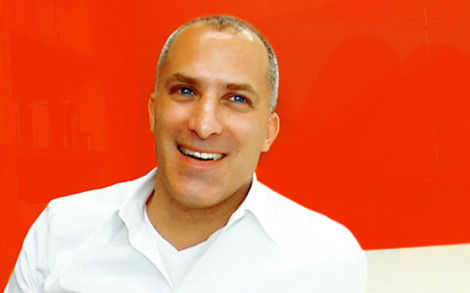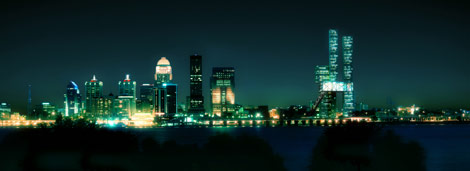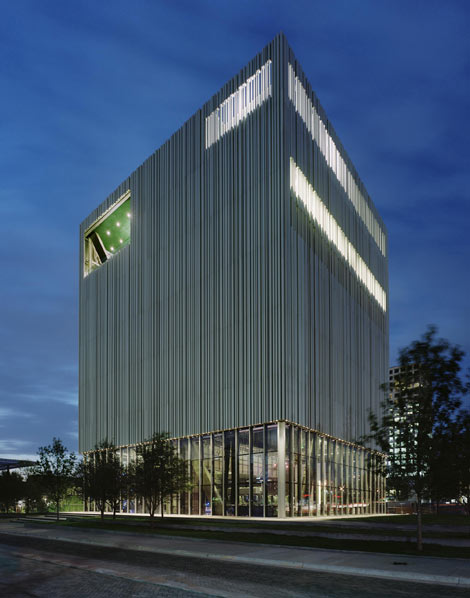
joshua prince-ramus
joshua prince-ramus was born in 1969.
he received a bachelor of arts in philosophy with distinction
from yale university in 1991 and a master of architecture from
harvard university in 1996. joshua prince-ramus is president
of REX and principal in charge of all projects. he was the
founding partner of OMA new york. while REX was still known
as OMA new york, prince-ramus was partner in charge of the
seattle central library and the guggenheim-hermitage museum
in las vegas. in addition to the recently completed at&t performing
arts center’s dee and charles wyly theatre in dallas, texas,
other cultural projects by REX include museum plaza,
a 62-story mixed-use skyscraper housing a contemporary
art center in louisville, kentucky, and the new central library
and music conservatory for the city of kortrijk, belgium.
current projects also include the istanbul headquarters for
vakko and power media, turkey’s preeminent
fashion and media companies; the university of louisville’s
college of business campus in kentucky; and a line of public
furniture for belgian furniture company quinze & milan.
REX recently placed second in both the international competition
for the new edvard munch museum in oslo, norway,
and the finnish innovation fund’s low2no sustainable development
competition in helsinki, finland. he is currently a visiting professor
at columbia university’s graduate school of architecture,
planning, and preservation, and has previously been a visiting
professor at both harvard and yale.

museum plaza, louisville, kentucky, 2009
image courtesy REX architecture
 museum plaza, skyline, louisville, kentucky, 2009
museum plaza, skyline, louisville, kentucky, 2009
image courtesy REX architecture

museum plaza, louisville, kentucky, 2009
image courtesy REX architecture

sitra, the finnish innovation fund low2no sustainable development, helsinki, finland, 2009
image courtesy REX architecture
see more images of this project here

the dee and charles wyly theatre by REX/OMA, at the AT&T performing arts center, dallas, usa
image © iwan baan

the dee and charles wyly theatre by REX/OMA, at the AT&T performing arts center, dallas, usa
image © tim hursley
---
we met joshua prince-ramus in new york on may 13, 2009.
---
what is the best moment of the day?
when I come home and my daughter yells 'daddy' and
runs to me.
what kind of music do you listen to at the moment?
sufjan stevens.
do you listen to the radio?
no.
what books do you have on your bedside table?
the master and margarita (by mikhail bulgakov) and
seven pillars of wisdom (by t. e. lawrence).
do you read design / architecture magazines?
no.
not even flip through them?
I flip through them (admits).
where do you get your news from?
my blackberry, in the morning, on my way to work.
I have a web news service.
I key in issues important to me and articles from the
new york times, the wall street journal, etc. get dumped
onto my blackberry.
I assume you notice how women dress.
do you have any preferences?
simple and elegant, but also sexy. I have a huge
partiality to prada and to miuccia (prada).
what kind of clothes do you avoid wearing?
I like very simple colors - light blue, white, grey and black.
I'm really uncomfortable with anything that has detail.
all I have are pure cuts.
I would never have a shirt that had funny buttons,
or a funny pocket.
do you have any pets?
not at the moment, but I had a cat.
when you were a child, did you want to
become an architect?
yes. since a very very very young age. since 5.
my grandfather was a very successful engineer and had
worked with a lot of very good architects and exposed
me to the field.
where did you study architecture?
your first job?
I studied at harvard. I graduated in '96 and rem koolhaas
was at the school and on my final review. I approached
him right afterwards and he offered me a job.
I went almost immediately to OMA and was in rotterdam
until 2000. my first job was a 70 thousand sqm office building
for universal studios in the hollywood hills with a budget of
350 million USD. I was directly out of school and the project
director was only two years out of school. we didn't have any
idea what we were doing (smiles and shrugs shoulders).
we just did it. lots of confidence and 'brute force.’ just energy
and conviction and figuring out as you go.
and REX architecture?
later I became a partner of OMA and came here
(new york) to open the US office in 2000. in 2006,
I bought rem (koolhaas) out of his half of the company and
changed the name.
you're well introduced
no question, I’m very, very lucky. but I would say that's true
of anyone who worked at OMA, because OMA is set up
without hierarchy. if you excel in that kind of environment,
you're given incredible opportunities that young people
would never ordinarily get. when we opened this office,
the first major project that we finished was the seattle
central library. it was an important building for OMA because
it was built very well. people began to understand that the
office was no longer just a bunch of kids, that we could deliver
really good pieces of architecture. it was also very
inexpensive. most people have no idea it cost only
272 USD per sq ft, which is about 2900 USD per sqm.
or 2000 € per sqm.
is a big restraint a good thing to start with?
the first thing we say to a client is 'tell us about your problems.
tell us your constraints. we'll make something out of them.’
of course every architect would like to have more money to
play with, but if there are big constraints, you're obliged to come
to very creative solutions. we've never seen a constraint
that we didn't like. the office's ethos is about not
designing objects, but designing processes... and to have
the confidence that with enough people, enough intelligence
and enough energy, the process will lead to a conclusion that
far exceeds anything you could have
sketched initially or individually. we call this the
'lost art of productively losing control.’
where do you work on your projects usually?
here in the studio, but in the beginning of a project
we work with the client at their place, their site, their office,
their institution... to understand how they operate.
describe your style like a good friend of
yours would describe it.
performance.
please describe an evolution in your work from your first
projects to today
actually, the seattle library for this office was a watershed
moment. frankly, it was one of the reasons why this office
eventually split from OMA. the analytical design process
on seattle was something that OMA had been thinking about
and advancing, but OMA does many things. OMA tries many
different avenues. on seattle, we pushed this highly rational
methodology very far. it was exciting and
everything we have done since has been an evolution to
that project’s design process. I don't think rem (koolhaas) was
as comfortable to be so focused on one way of working.
the research process we did with the seattle client, we have
repeated with every client since.
this was also the project that has given you the most
satisfaction until now?
yes, the seattle library. it was in 1999, at the height of the
internet technology boom. seattle was filled with
incredibly smart, wealthy people who were doing everything
they could to kill the book. they all believed religiously in the
internet, web TV, e-books... and therefore there was a lot of
skepticism about why the public library was spending
112 million USD to build a repository for books.
architects should guide collaborations rather than impose
solutions. so we agreed with the board and the city librarian
to research the situation and take collective positions
before starting to design. the library board included the
vice-president of boeing, the CFO of microsoft, the first
investor in bill gates' company... they were all used to
taking educated risks. we asked 'did the book still have
an important position within the information media explosion?'
and our collective position was 'yes!’ our analysis confirmed
that no really potent form of technology ever disappears.
who would you like to design something for?
an opera.
it’s the mother of the arts.
it deals with everything from dance to scenic
design to acting to music to...
it’s also an institution that is clearly in crisis.
since we're very interested in advancing and challenging
typologies, I think it'd be interesting to design a contemporary
opera. The opera's problem is not its
content. The problem is its form, decorum and the
expectations it puts on people. If you could design
an opera environment which appeals to 22 year olds, they
would go. and if they could be themselves...
if they could sit and drink and talk and watch (laughs).
is there any architect from the past you appreciate a lot,
who has influenced you?
certainly mies (van der rohe).
trying to think if there could be anybody else...
and those still working? contemporary ones?
(rem) koolhaas. rem was my mentor.
I don't know how else to put it.
certainly an enormous amount of our intellectual production
continues things that I learned or started while with OMA.
also, attempting to negate things that I learned or saw at OMA...
I'm either reinforcing or negating this experience.
it is still a dialogue, whether it's directly with him or not (laughs).
do you discuss about your projects
with other architects?
yes, I have a group of friends that were friends long before
any became successful. we talk. people like julien de smedt,
bjarke ingels, gary bates, arne quinze. I think one of the nice
things about this younger generation of architects and
designers, (laughs) anyone under 45, is that they are more
open. I'm not even sure it depends on age - it has maybe
more to do with our position within the profession, that we're
not so guarded and we don’t take the position 'these are my
toys and I don't want to talk.’ we talk about approaches to a
project and whether or not it's intellectually credible. we talk
about papers that we're writing and the ideas behind them.
for example, I happen to be very good at at contracts.
I have lawyers in my family and it is always something
I've understood. I send REX’s contracts to my colleagues and
say, 'this is how we fought for and established
intellectual property rights, and you should use this language.'
we also exchange information about standard fees and what's
expected. we have a feeling of ‘it's us against the world.’
what advice would you give to the young?
I have one specific piece of advice: don't follow conventional
paths. this is the best moment you could ever be a young
architect, because the playing field in this economy is
becoming even. for a long time, the older generations
ate the young. they're going down right now and there's
no definition of what architecture will be. don't try to get
a junior job at the best firm you can and spend the next
30 years working your way through. this is the moment
to move back home, use all your contacts and start
operating locally. do great work locally and define
what architecture will be for the next 50 years.
the more general advice is that no one can teach you
how to design. no one can teach you how to be creative.
but they can teach you to be self-critical. in school you
should focus on learning to be self-critical and on
contracts (laughs). spend most of your time
- if you're in architecture school - over at the law school
or the business school because that's where you're going
to learn tools. the real things you can learn in architecture
school are tools. focus on tools, not on your studio course.

© All Right Reserved. Copyright © ООО Информагентство СА "Архитектор" ©
Свидетельство о регистрации ИА №ФС1-02297 от 30.01.2007
Управление Федеральной службы по надзору за соблюдением законодательства в сфере массовых коммуникаций и охране культурного наследия по Центральному Федеральному округу.

